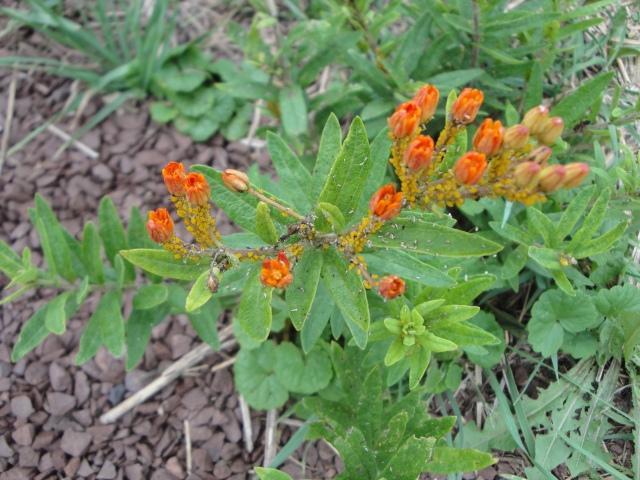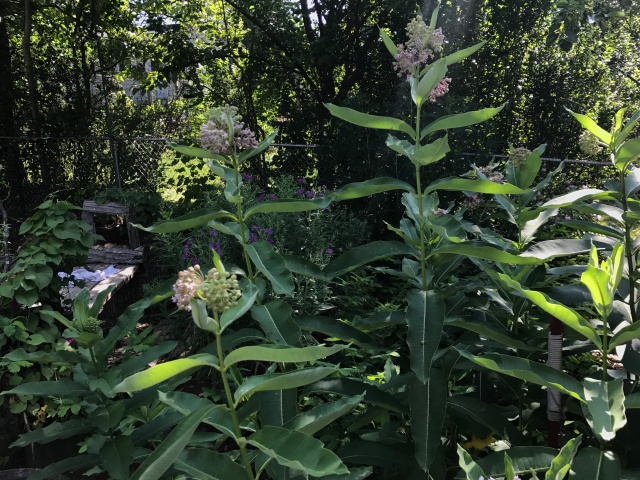I thought I would try something new, and start profiling each of the plants (or plant groups) in my butterfly garden as a complement to some of the more macro-level discussions I started with. There seems to be no better place to start than with the milkweeds (Asclepias sp.) Plants of this genus are the only hosts for North America’s most iconic butterfly, the monarch. They also attract a wide variety of other insects, for a variety of reasons. Several species are native to the mid-Atlantic, and a few others grow well here. I haven’t found any of these on lists of invasives, so I have chosen to include a sampling of both native and non-native species in my garden. I can confirm anecdotally that monarchs will readily use all as host plants and that many species will take nectar from the natives and non-natives alike.

Common milkweed (A. syriaca) is a native plant with lovely spheroid clusters of white-and-pink flowers. It can grow 5-6 feet (or more?) tall in good conditions. This is one of the first plants I started in my garden for perhaps obvious reasons. I have seen it in action hosting monarchs, milkweed tiger moths, swamp milkweed leaf beetles, small and large milkweed bugs, red milkweed beetles, and more. Seemingly every pollinator will make a stop at the flowers. It is fairly easy to grow from seed, especially if cold-stratified first. It seems to handle relocation well. This plant will thrive in moist but well-drained soils, but in my experience it will tolerate most conditions. I am always nervous about cutting back plants mid-season, but because monarchs prefer young leaves and breed in Maryland later than milkweeds emerge it is good practice to do so. The milkweeds can handle it.

Swamp milkweed (A. incarnata) is quite similar. As its name suggests, it does prefer things a little bit wetter. Mine hasn’t taken off quite as well as the common milkweed, but it does return each year. Its flower clusters are smaller and not the same near-spherical shape, but do tend to a brighter pink. The leaves and seed pods are narrower. Other than the wetness, the same plant care notes apply to swamp milkweed. I know it hosts monarchs and the swamp milkweed leaf beetle and I suspect the other insects mentioned above can eat it as well. It’s a great alternative to common milkweed for a wetter space.

I am still trying to establish some butterfly weed (A. tuberosa). I had read that this species can take a little longer than the others to get going, and this is proving true. Butterfly weed has bright orange flowers and clear (as opposed to milky) sap. So far none of my seedlings from previous years has survived – I don’t know if I have been choosing the wrong location, experiencing a run of bad luck, or something else, but I will keep trying. The orange would really be a nice accent to the rest of my garden’s color pallette. It’s also reportedly a great nectar plant for many pollinators, and since biodiversity is my ultimate goal any native plant that fits the host/nectar profile is a plant I want.
The Maryland Biodiversity Project lists nine additional species (plus two subspecies of swamp milkweed) as Maryland natives. Some appear to be quite rare, and others are limited to the coastal plain. The remaining few species are on my list of potentials for future plantings – clasping milkweed (A. amplexicaulis) looks particularly attractive. I’ll have to balance diversifying the milkweeds with filling other niches, though, so they may have to wait in queue for a few years.
I did mention non-natives, and thus far I have tried two of these. Last year I added some bloodflower (A. curassavica), a more southern species that nonetheless grows well here. I couldn’t resist the striking red-and-yellow flowers or the glossier green of the stems and leaves. I have observed monarch caterpillars munching on this plant and many insects taking its nectar, so I feel vindicated in sneaking in this non-native plant for variety’s sake. This year I am similarly experimenting with “showy” milkweed (A. speciosa), which is from the western half of the continent. I’m not sure if the seedlings survived the deluge we got earlier this month, but if they did I look forward to seeing if these perform as well as the bloodflower.

I haven’t had too many problems keeping milkweeds healthy once they’re established. One exception is the occasional infestation of oleander aphids. Perhaps coincidentally they have attacked my swamp milkweed most voraciously. The point of my garden is of course exploitation by animal life, but this non-native aphid does not contribute positively to the ecosystem so I don’t tolerate them. Fortunately they seem fairly easy to control. I have found manual removal to be very effective. I simply squish them by grasping the plant stems and rubbing, then rinse the gross yellow goo with a hose.

All in all, milkweeds are low-maintenance flowers that add a lot of visual interest to a garden. They check a lot of boxes in terms of ecological niches as well, even excluding their well-documented relationship with monarch butterflies. There’s very little not to like.

